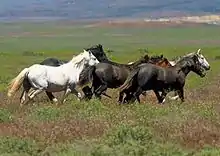Dilution gene
A dilution gene is any one of a number of genes that act to create a lighter coat color in living creatures. There are many examples of such genes:

The effect of the champagne dilution gene on different horse coats.
General
Diluted coat colors have melanocytes, but vary from darker colors due to the concentration or type of these pigment-producing cells, not their absence. Pigment dilution, sometimes referred to as hypomelanism, has been called leucism, albinism (perfect, impartial, or dilute), ghosting, paling, and isabellinism.[1]
Cats
- Cat coat genetics discusses many dilution genes in cats
Horses
- Equine coat color genetics discusses color genes in horses, including a brief description of dilution genes
- Equine coat color describes various colors in horses
- Cream gene, describes the process for horses by which the cremello, perlino, smoky cream double-dilute colors are created as well as the buckskin, palomino and smoky black single dilute colors.
- Dun gene describes another common dilution gene in horses
- Champagne gene, describes a different and rarer dilution gene in horses that also creates cream coloring, pale skin with mottling and light-colored eyes.
- Pearl gene, also called the "Barlink factor", is a recessive gene. One copy of the allele has no effect on the coat color of black, bay or chestnut horses. Two copies on a chestnut horse produce a pale, uniform apricot color of body hair, mane and tail as well as pale skin. It also interacts with Cream dilution to produce "pseudo-double" Cream dilutes with pale skin and blue or green eyes.
- Silver dapple gene, describes a dilution gene that works in a unique manner, lighting the mane and tail of a horse to a greater degree than the body color (opposite of most dilution genes, which act more strongly on the body color)
- White (horse) describes several unique genetic processes that create truly white, not diluted, color in horses.
- Gray (horse) explains the process of the gray gene, which lightens the coat over time, but is not a dilution gene.
- Mushroom (horse) describes an unknown and unmapped theorized dilution gene dilutes red pigment in body color to a pale beige color.
References
- Davis, Jeff N. (September–October 2007). "Color Abnormalities in Birds". Birding. American Birding Association. 39 (5).
See also
- wikispecies:Felis sylvestris catus (cat)
- wikispecies:Equus caballus (horse)
This article is issued from Wikipedia. The text is licensed under Creative Commons - Attribution - Sharealike. Additional terms may apply for the media files.
